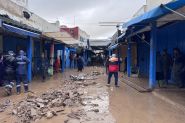- Home
- Multimedia
- On the Sidewalk of Forgetfulness: Lebanon’s Street Children Forced to Survive
Child begging is an increasingly alarming issue in Lebanon. Amid a devastating economic collapse and political turmoil, more than 1,500 children are reportedly abandoned in the streets across the country. Beyond the humanitarian emergency, this crisis is a stark reflection of systemic failure, demanding immediate government intervention.
At an age when they should be playing and learning, these children are weighed down by harsh realities. One hand offers chewing gum, flowers or tissues for sale; the other carries the burden of a childhood stolen too soon. School is a distant dream. Safety is out of reach. Innocence is lost.
A UNICEF and Save the Children report reveals that these children (approximately 1,500) are scattered across Lebanon, from rural villages to sprawling urban centers like Beirut and Tripoli. Many have been abandoned or exploited, sometimes by their own families. Palestinian and Syrian refugee camps in the Beqaa Valley harbor a significant portion of these vulnerable youths, making them especially exposed to exploitation by informal economic networks.
To tackle this issue, it is crucial to understand its root causes, map its scope and challenge the collective responsibility society has shirked by turning a blind eye.
A Crisis Rooted in Collapse
Lebanon’s economy has been in freefall for years: financial institutions collapsed, inflation soared and currency values plummeted. For the poorest families, basic survival has become an impossible challenge, pushing children into the streets.
The influx of Syrian refugees fleeing war has compounded the problem. Many displaced families live in poverty, with children facing neglect, abuse and exploitation, often driving them to fend for themselves on the streets.
Family breakdowns further worsen the situation. Divorce, domestic violence and poverty lead to abandonment or force children into begging. Some flee violent homes, only to find themselves exposed to new dangers in public spaces.
A Visible Daily Reality
Street children are highly visible in Beirut and Tripoli, as well as in rural regions like the Beqaa Valley and southern Lebanon near refugee camps. They gather in shopping centers, public markets and tourist areas, hoping to catch the attention of passersby.
According to UNICEF and Save the Children, about 10% of street children are Lebanese. Syrians make up around 65%, while Palestinians account for roughly 8%. The remainder includes unregistered children and ethnic minorities.
A Call for Policy
Effective solutions require more than charity and temporary fixes. NGOs and local organizations play a crucial role, but they need strong backing through comprehensive, well-funded public policies.
Removing these children from the streets won’t solve the problem. The root causes run deeper within families, schools and social institutions that have all failed these children.
Some dismiss the issue because most affected children are refugees. But these children live on Lebanon’s sidewalks and bear the consequences of a war that, though not theirs, now defines their reality.
The tragedy of abandoned street children in Lebanon can no longer be ignored. It is a symptom of a collapsing social fabric that demands urgent, compassionate and responsible action.
Lebanon may not have chosen this crisis, but it must now face its consequences with resolve.
Read more





Comments